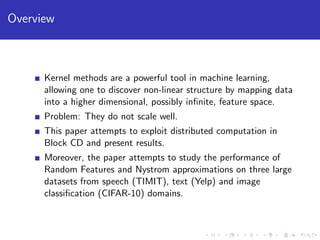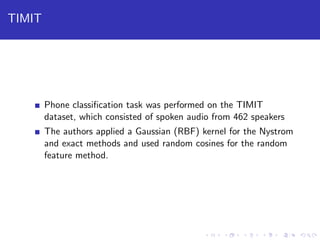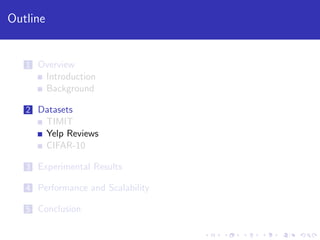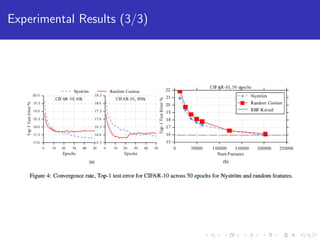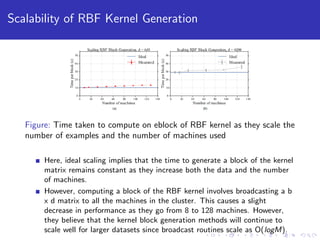Large Scale Kernel Learning using Block Coordinate Descent
- 1. Large Scale Kernel Learning using Block Coordinate Descent Shaleen Kumar Gupta, Research Assistant3 Authors: Stephen Tu1 Rebecca Reolofs1 Shivaram Venkatraman1 Benjamin Recht1,2 1Department of Electrical Engineering and Computer Science UC Berkeley, Berkeley, CA 2Department of Statistics UC Berkeley, Berkeley, CA 3Nanyang Technological University, 2016
- 2. Outline 1 Overview Introduction Background 2 Datasets TIMIT Yelp Reviews CIFAR-10 3 Experimental Results 4 Performance and Scalability 5 Conclusion
- 3. Outline 1 Overview Introduction Background 2 Datasets TIMIT Yelp Reviews CIFAR-10 3 Experimental Results 4 Performance and Scalability 5 Conclusion
- 4. Overview Kernel methods are a powerful tool in machine learning, allowing one to discover non-linear structure by mapping data into a higher dimensional, possibly infinite, feature space. Problem: They do not scale well. This paper attempts to exploit distributed computation in Block CD and present results. Moreover, the paper attempts to study the performance of Random Features and Nystrom approximations on three large datasets from speech (TIMIT), text (Yelp) and image classification (CIFAR-10) domains.
- 5. Outline 1 Overview Introduction Background 2 Datasets TIMIT Yelp Reviews CIFAR-10 3 Experimental Results 4 Performance and Scalability 5 Conclusion
- 6. Kernel Methods https://www.reddit.com/r/MachineLearning/comments/15zrpp/please_explain_support_vector_machines_ svm_like_i/c7rkwce If our data can’t be separated by a straight line we might need to use a curvy line.
- 7. Kernel Methods https://www.reddit.com/r/MachineLearning/comments/15zrpp/please_explain_support_vector_machines_ svm_like_i/c7rkwce If our data can’t be separated by a straight line we might need to use a curvy line. A straight line in a higher dimensional space can be a curvy line when projected onto a lower dimensional space. So what we are really doing is using the kernel to put our data into a high dimensional space, then finding a hyperplane to separate the data in that high dimensional space. This straight line looks like a curvy line when we bring it down to the lower dimensional space.
- 8. Kernel Approximation Techniques (1/2) Kernel Trick: The essence of the kernel-trick is that if you can describe an algorithm in a certain way – which is using only inner products – then you never need to actually use the feature mapping, as long as you can compute the inner product in the feature space. While there are many kernel approximation techniques to do the Kernel Trick, one prominent one is using the RBF Kernel. We will also analyze two other Kernel approximation techniques, namely Nystrom Method and Random Features Technique, in this paper.
- 9. Kernel Approximation Techniques (2/2) If we would use all data points, we would map to an RN dimensional space and have the scaling problems. Also, we would need to store all kernel values. Nystrom method says that we don’t need go to the full space spanned by all N training points, but we can just use a subset. This will only yield an approximate embedding but if we keep the number of samples we use the same, the resulting embedding will be independent of dataset size and we can basically choose the complexity to suit our problem. Random feature based methods use an element-wise approximation of the kernel.
- 10. Outline 1 Overview Introduction Background 2 Datasets TIMIT Yelp Reviews CIFAR-10 3 Experimental Results 4 Performance and Scalability 5 Conclusion
- 11. TIMIT Phone classification task was performed on the TIMIT dataset, which consisted of spoken audio from 462 speakers The authors applied a Gaussian (RBF) kernel for the Nystrom and exact methods and used random cosines for the random feature method.
- 12. Outline 1 Overview Introduction Background 2 Datasets TIMIT Yelp Reviews CIFAR-10 3 Experimental Results 4 Performance and Scalability 5 Conclusion
- 13. Yelp Reviews The goal was to predict a rating from one to five stars from the text of a review. A usual 80:20 Training:Test split was applied nltk was used for tokenization and stemming and n-gram modeling was done with n=3. For the exact and Nystrom experiments, they apply a linear kernel. For random features, they apply a hash kernel using MurmurHash3 as their hash function. Since they were predicting ratings for a review, they measured accuracy by using the root mean square error (RMSE) of the predicted rating as compared to the actual rating.
- 14. Outline 1 Overview Introduction Background 2 Datasets TIMIT Yelp Reviews CIFAR-10 3 Experimental Results 4 Performance and Scalability 5 Conclusion
- 15. CIFAR-10 The task was to do image classification of the CIFAR-10 dataset. The dataset contained 500,000 training images and 4096 features per image. The authors started with these 4096 features in the dataset as input and used the RBF kernel for the exact and Nystrom method and random cosines for the random features method.
- 16. Experimental Results (1/3) Figure: Classification Error against Time using different methods on the TIMIT, Yelp and CIFAR-10 datasets. The little black stars denote the end of an epoch
- 17. Experimental Results (2/3) Figure: Classification Error against number of features for Nystrom and Random Features on the TIMIT, Yelp and CIFAR-10 datasets
- 19. Performance Figure: Breakdown of time to compute a single block of coordinate descent in the first epoch on the TIMIT, Yelp and CIFAR-10 datasets From the figure, we see that the choice of the kernel approximation can significantly impact performance since different kernels take different amounts of time to generate. For example, the hash random feature used for the Yelp dataset is much cheaper to compute than the string kernel. However, computing a block of the RBF kernel is similar in cost to computing a block of random cosine features.
- 20. Scalability of RBF Kernel Generation Figure: Time taken to compute on eblock of RBF kernel as they scale the number of examples and the number of machines used Here, ideal scaling implies that the time to generate a block of the kernel matrix remains constant as they increase both the data and the number of machines. However, computing a block of the RBF kernel involves broadcasting a b x d matrix to all the machines in the cluster. This causes a slight decrease in performance as they go from 8 to 128 machines. However, they believe that the kernel block generation methods will continue to scale well for larger datasets since broadcast routines scale as O(logM).
- 21. Conclusion This paper shows that scalable kernel machines are feasible with distributed computation. Results suggest that the Nystrom method generally achieves better statistical accuracy than random features However, it can require significantly more iterations of optimization. On the theoretical side, a limitation of this analysis is that achieving rates better than gradient descent cannot be hoped.
- 22. References and Further Reading I Stephen Tu, Rebecca Roelofs, Shivaram Venkataraman, Benjamin Recht Large Scale Kernel Learning using Block Coordinate Descent February 18, 2016 Tianbao Yang, Yu-feng Li, Mehrdad Mahdavi, Rong Jin, Zhi-Hua Zhou Nystrom Method vs Random Fourier Features: A Theoretical and Empirical Comparison Advances in Neural Information Processing Systems 25 (NIPS 2012)



